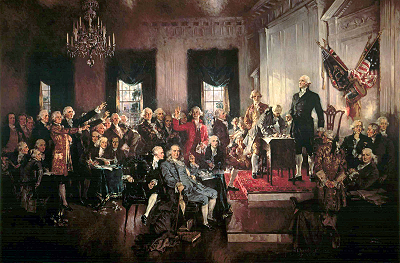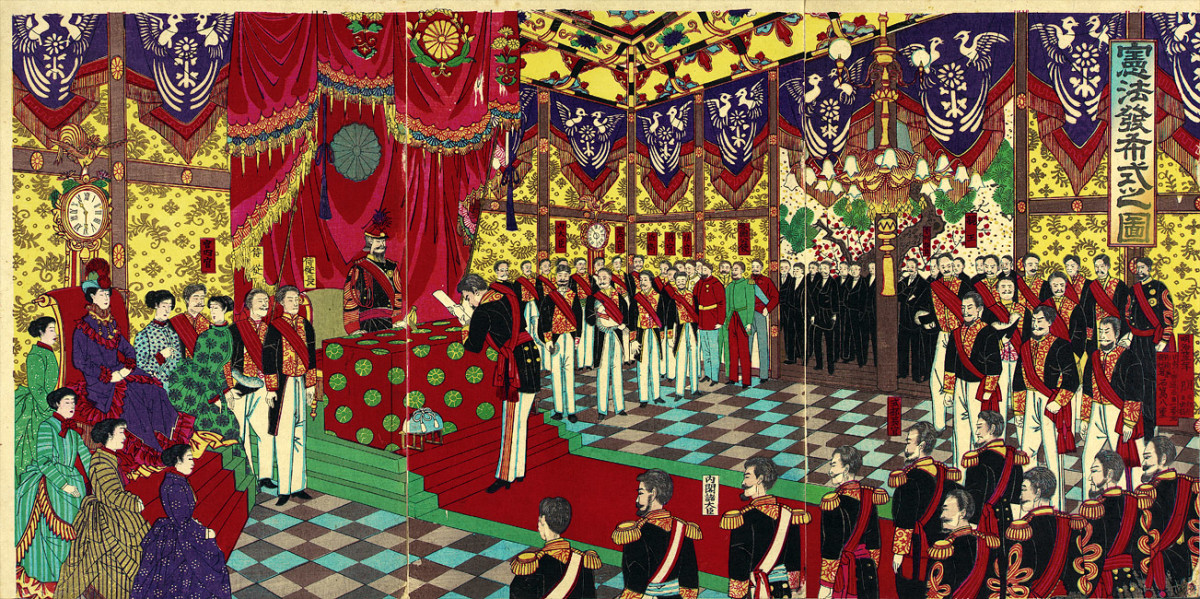On Principle and Pragmatism VIII - Understanding the Conservative/Tea Party-Liberal Philosophical Split
THE FOUNDERS HAVE GATHERED

A Unique Sort of Hub
THIS IS GOING to be a very unique hub, I think, in that the reader must be a participant for it to work and make any sense. It is going to be a two-part hub starting off with a series of Poll questions to ascertain what people believe about the U.S. Constitution and therefore where they stand on the issue of whether we have strayed from what the framers of the Constitution had in mind when they wrote and signed-off on the U.S. Constitution. This is because, much is made by the Tea Party and Conservative political candidates and their supporters about how we have America has left the Constitution behind in the liberal push toward big government; that the path that government is on today is not the path the signers had in mind when they put their names to the Constitution on September 17, 1787, 230 years ago.
Hopefully, this will give some insight on how each political group in America, Liberal, moderate, and Conservative, view what was the intention behind the Constitution and the purpose it was written. I hope it will be illuminating.
The second part, to be written later, assuming enough people voted to make it worthwhile, will analyze the vote and the questions asked. I know trying a poll in this fashion is very problematic, given the reticence hubbers have in expressing their opinion via the hub polls, but, I thought I would try anyway; always the optimist.
I use the more cumbersome poll because I can gather more interesting information from it even though a quiz gets to the same bottom-line much more easily. The poll, if enough people respond, will allow me to do what is called "stratification", which gives more insight into the answer.
The polls are straight-forward; I make a statement (12 altogether) and you answer whether you agree or disagree (if you are unsure, go with your gut). The cumbersome part is I give you three "yes" and three "no" choices, one each for if you consider yourself a Liberal, a Moderate, or a Conservative/Tea Party member.
I will let you know what I think it means once I have enough votes logged in, so please vote.
UPDATE - Even with only 5 to 7 votes so far, I am a bit surprised by the responses over my preconceived notions. For a couple of the questions, I am getting the answers I was expecting, but in others, I find it very interesting the initial split even within a political category.
I also want to add, there are no right or wrong answers to any of these questions because these questions relate to purpose and perception and not to mechanics, and the former are matters of opinion and interpretation.
2018 - Although, six years later, I am still shy enough responses, there are at least enough to point toward a pattern. I add comments below each poll.
YOU MIGHT SEE TWO STATEMENT NUMBER 6s below. I didn't like the way I phrased it originally; it seemed confusing to me after rereading it later. I closed the original poll and started a new one for that statement.
1.The Advice and Consent clause, the six-year term, and it's 2-member from each State composition gives the Senate too much Executive Power, makes it Unequal in principle, and tends toward Aristicracy
N = 19
This was a very hotly contested issue at the Constitutional Convention. Two of the major issues facing our founders is how to properly split the powers between the three branches of government and the two houses of the legislature.
There were competing fears of letting mob rule, as in a true democracy, and the aristocracy they were trying to get away from.
The advice and consent was inserted near the end, once they had settled on executive powers. They rightly felt there needed to be a check on the president. Unfortunately, they were also hoping their plan would limit "factions" in the new government, but we know how that has worked out. Most of the history of the United States has been the division and partisanship we all hate. That was one reason the Senate inserted the filibuster rule, to avoid tyranny by the majority.
The hyper-partisanship we have today, while not unheard of, is rare in our history. Normally there were enough factions within a party (such as there still are in the Democratic Party today) that voting in lockstep was uncommon. It isn't today.
The six-year term was a nod toward the "career politician". The founders recognized that a government cannot function with all novices at the helm, a situation we see with Donald Trump and a good portion of the Republican House. They understood that experience matters - a lot. So to that end, in order to try to keep the House of the People fresh, a two-year term was given. For the Senate, where they expected more reasoned analysis based on the wisdom gained over time, they provided a six year term with 1/3 up for election every two years.
Historically, it was the liberals who agreed with the Senate structure and powers and the conservatives (anti-Federalists) who opposed it. Some of the reasons for opposition is it installs aristocracy into the fabric of our nation and it gave the Senate too much power.
The preliminary results of this poll show that in America today, all political persuasions tend to think the Senate is properly constituted.
2. Our Founders Never Intended for the Supreme Court to be able to Exercise Judicial Review.
Actually, our founders were more or less silent on this subject of Judicial Review. If fact, it doesn't seem they gave a whole lot of thought to what the Supreme Court's powers and jurisdictions ought to be. Maybe that was on purpose.
In any case, "Judicial Review", the power of the Supreme Court to determine if a law was constitutional or not was the result of a stand-off between President Thomas Jefferson and Chief Justice John Marshall. The case was Marbury v Madison. Madison was James Madison, the attorney general and Marbury was appointed Postmaster General by the outgoing President John Adams.
Jefferson didn't want to seat an Adams' appointee and wouldn't finalize the appointment even though Marbury had been notified the job was his. Marbury sued saying a law on the books required Jefferson to finish the appointment.
This was an original test of the power between the executive and judicial branches. At the end of the day, the judicial branch has no enforcement mechanism, only the executive branch does. Marshall knew that Jefferson was going to defy the Court if they ruled for Marbury, thereby eviscerating the Court's power. Marshall also knew that if he caved to Jefferson's will, the same thing would happen.
In order to protect the Court from the Executive, Marshall did an end run around the issue by ruling, with appropriate reasoning, that the law Marbury was relying on was itself unconstitutional. This was the first use of Judicial Review, a power Jefferson didn't like either but could do nothing about. In the end, Jefferson had his way and Marbury wasn't seated but the Court increased its power immeasurably. In the 200+ years since then, Congress, who could have done something, didn't.
So, the answer to the poll question is that our founders didn't "intend" for the Court to have the power of judicial review, but they didn't "not intend" it either. But, given that it does exist, it seems our liberal and moderate friends seem to think it is a good idea and the conservatives are split on the issue.
3. The phrase "Provide for the General Welfare" in the Preamble and in the Constitution was intended to apply Just to the Nation as a Whole and Not to its Citizenry
If you read the history of how our Constitution came to be and the wording used, there is no "clear" answer to what the founders had in mind. But based on the readings I have done to date, I side with the idea that they DID intend for that part of the Preamble to apply to the citizens.
That is based on the tone and wording for comments made during the Constitutional Convention as well as other writings. It is very clear that it was the citizens of the soon to be United States that was foremost on their minds and not the states nor the federal government itself. So, why would there be an exception cut out for General Welfare. It seems to me that idea was directed at the people, and through the people, the nation.
This is where we have a clear break between conservatives and everybody else, at least at this point in time. One possible reason might be how the word "welfare" is interpreted. The kind of social support systems we have today to help those in need didn't exist in the late 1700s. Consequently, it isn't that type of 'welfare' the founders were thinking of. Instead, it was the broader definition that they had in mind of which social support systems is a small subset.
4. The Founders Overstepped Their Mandate to Modify the Articles of Confederation when They wrote the U.S. Constitution.
5. The Constitution was written such that future Congresses could apply it so as to accomodate Technology and Societal norms prevelant at the Time.
6. "Arms" as used in the 2nd Amendment, is not limited to Pistols and Muskets , but also to smooth-bore Artillary and other such weapons as well, which were common at the Time.
EDITED STATEMENT: 6. "Arms" as used in the 2nd Amendment, is not limited to just to Pistols and Muskets but includes more powerful and dangerous weapons as well.
7. The Founders, in writing the Constitution, intended for the Executive Branch to have equal Power as the Congress.
8. The Founders, in writing the Constitution, intended the Judicial Branch to have equal Power to the Congress,
9, It was intended, by those who wrote and signed the Constitution, that Principles unique to the Christian Religion have an influence in the Federal Government.
10. In writing the Constitution, the Founders are Silent on whether "Arms", as used in the 2nd Amendment, can be Regulated by State and Federal Government.
11. The Writers of the Constitution Intended for the relationship between the States and Federal government to Change significantly from the Ariticles of Confederation.
12. The Constitution was Not intended, by its writers, to by a Living document but, instead, immutable.
© 2012 Scott Belford








